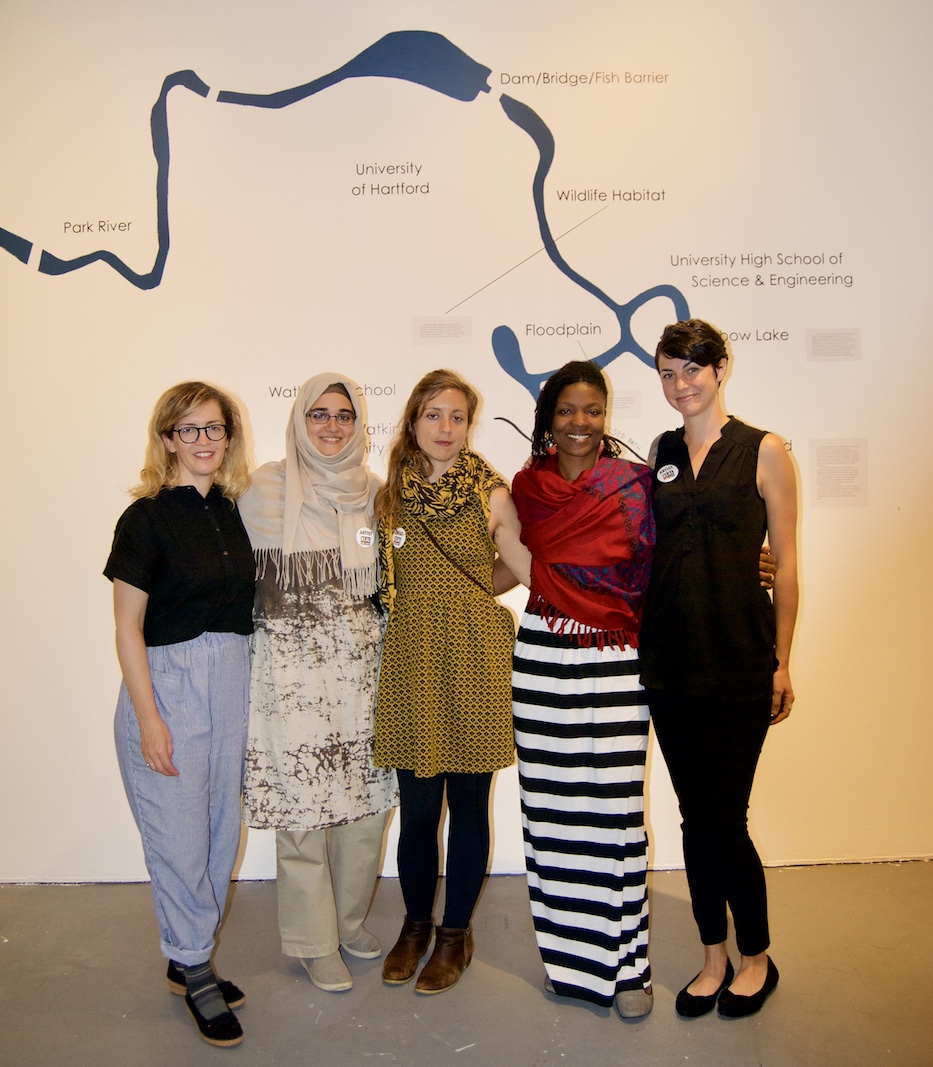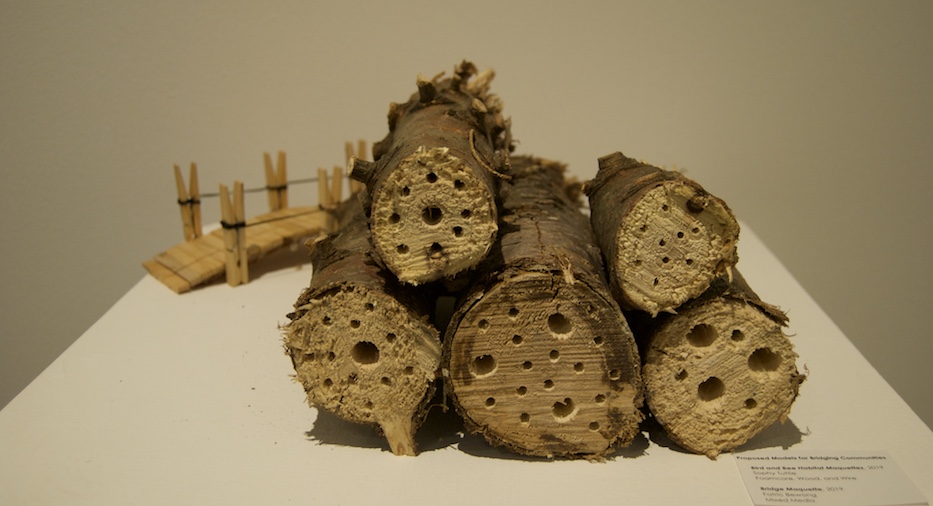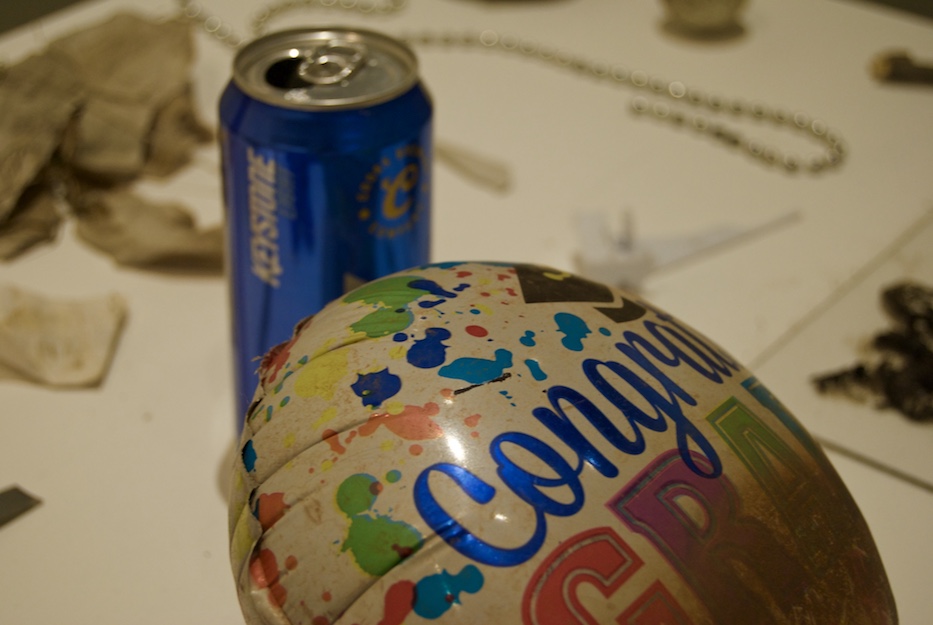
Hartford | Arts & Culture | Visual Arts | Real Art Ways

| Nomad/9 MFA Cohort Two: (L-to-R) Mary Mattingly, Zahar Al-Dabbagh, Blair Butterfield, Fatric Bewong, and Sophy Tuttle. Kerri Provost Photos. |
A dull rainbow of glass shards has been neatly arranged on a low, white rectangle, as if the shards are scientific specimens. But there’s more: a dingy condom wrapper, beer can, plastic straw, and an assortment of unidentifiable-yet-ubiquitous scraps.
The collaborative piece, “Objects from the Park River,” is part of P.A.R.K. Bridging Communities, an exhibition from multiple cohorts of the Nomad/9 MFA program at University of Hartford’s Hartford Art School. The show, which uses the Connecticut River tributary as inspiration, runs simultaneously at Silpe Gallery and Real Art Ways through June 29.
Artists gathering around Hartford’s environmentally downgraded Park River is not a new idea. The Art Society of Hartford held an outdoor sketching class in 1920 along the bank near Lorraine Street in the city’s West End, where girls would draw lush woodland scenes and receive critiques weekly.
Samuel Rowlett’s performance art piece in 2012—he dragged a 75-pound concrete block behind him while walking city streets—was inspired by how his boat scraped against the river’s concrete channel. From 2010-2013, several short artistic and documentary films were produced about the capped segment of the Park River, the partial burial of which happened in phases over several decades in the 20th century.

| Bridge Maquette by Fatric Bewong and Solitary Bee Habitat by Sophy Tuttle. |
The river’s more natural North Branch, which flows through the University of Hartford campus, has garnered attention because it is visible from the Hartford Art School. In 1972, a student built a dam and rearranged stones in the river. His actions were criticized at the time, out of concern that he was damaging the ecosystem.
Others have tried to capture the sound of the river. In 1995, Karen McCoy was reported by the Hartford Courant to have installed “ear trumpets tethered to boulders so you can tune in to the sound of the currents in the Park River.” Hartt School of Music students composed music from birds and other ambient sounds collected along the river in 2012.
Mary Miss, in collaboration with Mary Rickel-Pelletier, installed oversized, red pins at locations in the Park River Watershed and developed corresponding gallery and print maps with information about each pin’s site as part of the City as Living Laboratory project.
And now, there’s P.A.R.K. Bridging Communities.
Mary Mattingly, a teacher in the program, said the theme was suggested by Carol Padberg, a lover of the Park River and Nomad/9 founder and director. Mattingly, who has previously centered her artwork on rivers and barges—her Swale project in New York City is what she calls a “public floating food forest”—was not outside her comfort zone.
Through collaboration, the students in this low-residency, interdisciplinary program aimed to devise metaphorical bridges between the campus and Blue Hills neighborhood. Many of them found that it was a challenge: upon hearing their assignment, Blair Butterfield said her cohort’s reaction was, “We’re not bridge designers!”

Zahar Al-Dabbagh, who is from Saudi Arabia, asked if the creation needed to be “a literal bridge.” She later recalled floating on a raft that the cohort created and placed in the Park River, where she saw fireflies for the first time.
“Magical,” she said.
Magic was a word these students used often to describe the experience of interacting with the North Branch of the Park River, which passes along sprawling surface parking lots as well as through wooded areas.
Fatric Bewong created a bridge maquette that could be viewed during a charette. Sophy Tuttle’s “Map of the Park River: Community Assets,” shows the potential location of this bridge and a path that would connect an off-campus community garden with a vacated housing project currently undergoing demolition.
Al-Dabbagh spoke of wishing to create awareness of the “creatures living” in the river’s environment. Deer, bear, and bobcat have all made the watershed their home. Tuttle’s “Solitary Bee Habitat” suggest designs for regenerative culture, a step beyond sustainability.
In an attempt to create dialogue with the community—none of the MFA students live in the Hartford area—one facet of the P.A.R.K. Bridging Communities project asked residents what prevents them from experiencing the Park River, and how they would like to interact with it.
Butterfield considered the “physical barriers to the river,” like poison ivy. On an interactive wall at Real Art Ways, visitors shared that ignorance of the river’s existence blocked them from enjoying it.
Despite the intention to connect community with river, it remains to be seen how successful this cohort can be at meeting this goal, as those in the Blue Hills neighborhood directly off campus and along the Park River’s east bank were not among those attending the recent charrette. It’s a hiccup not exclusive to this cohort; artists have long struggled to link themselves to those living in communities immediately along the Park River, and often show no sign that they have researched what their artistic ancestors have created. Yet, this recent group has added a layer to what preceding NOMAD students have worked on, suggesting a possibility that the trend will change.
Next up, Fatric Bewong, based in Ghana, has an upcoming residency on Copenhagen, where she will focus on water and climate change. Tuttle will be connecting this to her work around the Esplanade in Boston and Mystic River in Medford, Mass.
Butterfield said she hoped the group’s project would show that it is possible to make “the place you live the place you want to live.”
Students will be continuing to record the oral history of the Park River: call 303-332-5028 to leave a voicemail with your personal or historical Park River stories.

